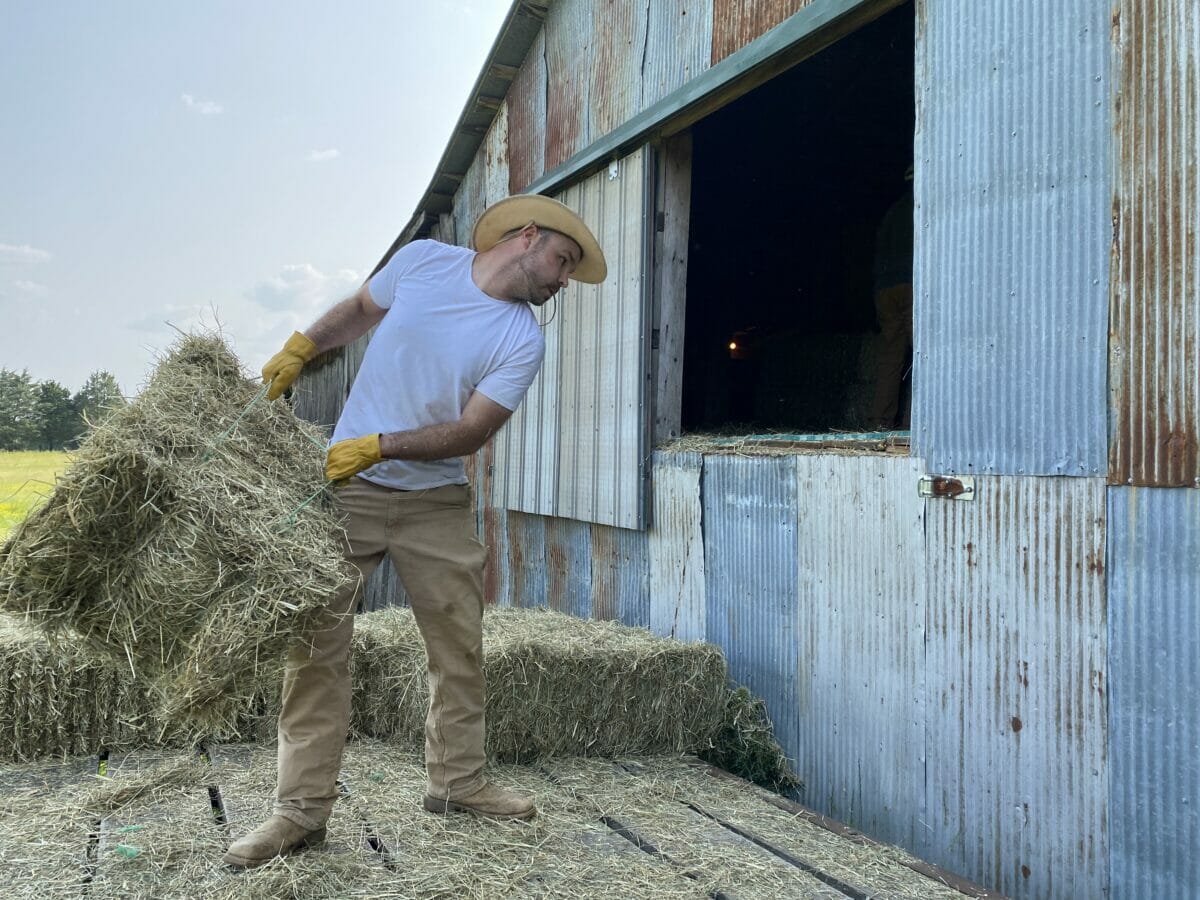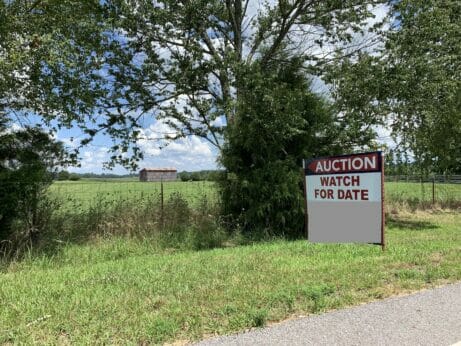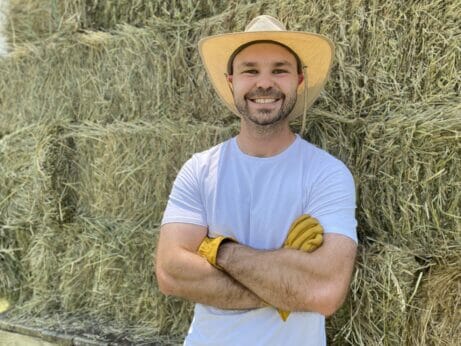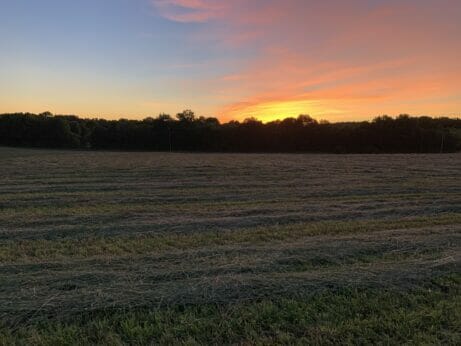Opinion: In American Agriculture, Size Matters
Consolidation is threatening small and midsized farms with extinction. Here’s why that’s a big problem.
Opinion: In American Agriculture, Size Matters
Consolidation is threatening small and midsized farms with extinction. Here’s why that’s a big problem.

For decades, farmers have been told to “get big or get out.” Photo courtesy of Regan Adolph.
Small farmers are struggling. For decades, they’ve been told to “get big or get out,” an imperative levied against them by both public and private forces.
Recent statistics on American agriculture reveal a decline of 200,000 farms between 2007 and 2022. Since 1935, we’ve seen a decrease of 4.8 million farms—to 2 million from 6.8 million. As agriculture has industrialized and become more capital-intensive, leading to dominance by wealthy, large-scale producers, much of the decline has come at the expense of small and midsized farmers.
This phenomenon isn’t just happening in the United States. New research published in Nature Sustainability projects that, if trends continue, the number of farms across the world will be sliced in half by the end of the 21st century as consolidation of land, wealth and power reshapes our farming and food landscape.
The marginalization of smaller-scale farms has severe consequences. When farms are continually consolidated—when there is one 5,000-acre farm in a community, for example, instead of 50 100-acre farms—fewer people remain in rural areas. That decreased population leads to social and economic impacts, with ripple effects that harm small businesses, school systems and other community institutions.
Read More
Transfarmation: The Movement to Free Us From Factory Farming
It’s even worse when the owners of large-scale farms don’t live in or meaningfully contribute to the community. Recognizing the value of farmland and the fact that, as a popular phrase goes, “they’re not making any more land,” investors are buying up agricultural acreage. These investors vary from agri-business “farmers” who manage operations from far-away offices to private equity firms. Their deep pockets price out new and underserved farmers looking to purchase land and root into a community. Data shows that land access is the biggest challenge faced by aspiring next-generation agrarians.

Environmental and agricultural impacts loom, too. Small farms tend to be more diversified than large-scale operations. That diversity supports healthier wildlife habitat, improved soil health and greater climate resiliency. These farms are essential for food security and local and regional food systems, where products grown in a community can stay in that community rather than being shipped across the country. While we’re all tired of talking about the COVID-19 pandemic, we should remember the importance of these smaller farms and local markets when the industrial food system couldn’t stock grocery store shelves.
Learn More
A Pathway to Land Access for Farmers
If we dig deeper, another less obvious threat emerges from the consolidation of American agriculture: a growing disconnect with the land itself. Smaller-scale farmers often have an intimate awareness of their place. Their landscapes are small enough to know and close enough to touch, leading to an “eyes-to-acres” ratio, as conservationist Wes Jackson calls it, that enables attention and care.
That “ratio” changes from place to place. After all, a “small farm” in my home state of Tennessee is different than a “small farm” in Kansas or Montana, Massachusetts or Maine. But the capacity for awareness and attunement remains.
In Love for the Land: Lessons from Farmers Who Persist in Place, I explore these connections with the land, as well as the challenges that make maintaining connections difficult. In two Tennessee counties, which serve as microcosms of our current agricultural situation, I interviewed dozens of farmers and local leaders who shared the impacts of consolidation. “I hate it,” one person said, “but the farm program we’ve got today put the ‘little guy’ out of business. The little farmers can’t keep up with the big ones.”

It isn’t just consolidation threatening these small and midsized farmers. They also face pressure from real estate development. “Bedroom communities” are transforming once-rural places as people who work in nearby cities look to the hinterlands to build houses. Yet, because these new residents spend most of their waking hours in other places working, shopping and eating, they may not be invested in their new home areas. Ironically, their homes may be on large residential lots that qualify as “farms” given lax definitions.
Farmland conversion to subdivisions, strip malls and low-density housing is acutely affecting Tennessee, but it’s prevalent across the country. According to American Farmland Trust, Tennessee alone is expected to convert more than one million acres of agricultural land between 2016 and 2040, while the United States is on pace to compromise 18.4 million acres. Conversion will especially affect smaller farms.
Additional challenges await “underserved” populations, such as Black farmers. Those interviewed for the book describe facing racial injustices in the past and present on top of other agricultural and economic difficulties, which is consistent with the experiences of farmers of color across the United States.
Even in the face of consolidation, rural gentrification and systemic racism, some smaller-scale farmers persevere. Their sometimes-self-sacrificial stewardship is driven by love for the land, leading to what farmer-writer Wendell Berry describes as fidelity or devotion to place. When told to “get big or get out,” these farmers choose neither. In doing so, they show us the power and potential of people-place relationships.
We can all learn from these farmers’ examples. Whether we live on farms or in small towns, suburbs or big cities, we can connect with the earth where we are. That may be on a farm or it may be in a backyard, a community garden or an urban park. In various settings, we can work to cultivate affection and fidelity. Nurturing these virtues would lead to collective, empathetic care for our places, our neighbors and the planet.

Yet, we must do more than learn from these farmers. We also need to support them.
We can leverage love for the land into strategies and policies that support right-sized farming, rural communities and the environment—which in turn helps us all. One such way to yield progress is through the creation of an Office of Small Farms within the United States Department of Agriculture. Too often, federal farm programs take a “one-size-fits-all” approach that simply doesn’t work for many farmers. With a federal office focused exclusively on assisting America’s small farms, we can help these essential people and places get the resources, technical assistance and information they need.
Read More
Factory Farms Make Bad Neighbors. Meet the People Who Are Fighting Back
Legislation to establish an Office of Small Farms has been widely endorsed by a diverse group of individuals and organizations. “Small farms are the heart and soul of our agricultural landscape, contributing to our economy, food security and the resilience of our local food supply chains. It’s time we do more to ensure that all farmers, regardless of the size of their farms, have equitable access to the support they need to flourish,” says Senator Cory Booker, a co-sponsor of the bill.
An Office of Small Farms won’t fix all the problems in our agricultural system. But it’s a much-needed start that should appeal to anyone who has the true needs of America’s rural communities and small family farmers at heart, regardless of political affiliation.
Statistics and on-the-ground evidence show that, in agriculture, size matters. Rather than stand back and watch consolidation continue, we can learn from the small and midsized farmers who persist, and we can work to ensure a future for farming that values attention and affection.
Brooks Lamb is the author of Love for the Land: Lessons from Farmers Who Persist in Place (Yale Univ. Press, 2023). He also works as the land protection and access specialist at American Farmland Trust. Brooks grew up on a small family farm in rural Tennessee.
Follow us
This work is licensed under a Creative Commons Attribution-NoDerivatives 4.0 International License.
Want to republish a Modern Farmer story?
We are happy for Modern Farmer stories to be shared, and encourage you to republish our articles for your audience. When doing so, we ask that you follow these guidelines:
Please credit us and our writers
For the author byline, please use “Author Name, Modern Farmer.” At the top of our stories, if on the web, please include this text and link: “This story was originally published by Modern Farmer.”
Please make sure to include a link back to either our home page or the article URL.
At the bottom of the story, please include the following text:
“Modern Farmer is a nonprofit initiative dedicated to raising awareness and catalyzing action at the intersection of food, agriculture, and society. Read more at <link>Modern Farmer</link>.”
Use our widget
We’d like to be able to track our stories, so we ask that if you republish our content, you do so using our widget (located on the left hand side of the article). The HTML code has a built-in tracker that tells us the data and domain where the story was published, as well as view counts.
Check the image requirements
It’s your responsibility to confirm you're licensed to republish images in our articles. Some images, such as those from commercial providers, don't allow their images to be republished without permission or payment. Copyright terms are generally listed in the image caption and attribution. You are welcome to omit our images or substitute with your own. Charts and interactive graphics follow the same rules.
Don’t change too much. Or, ask us first.
Articles must be republished in their entirety. It’s okay to change references to time (“today” to “yesterday”) or location (“Iowa City, IA” to “here”). But please keep everything else the same.
If you feel strongly that a more material edit needs to be made, get in touch with us at [email protected]. We’re happy to discuss it with the original author, but we must have prior approval for changes before publication.
Special cases
Extracts. You may run the first few lines or paragraphs of the article and then say: “Read the full article at Modern Farmer” with a link back to the original article.
Quotes. You may quote authors provided you include a link back to the article URL.
Translations. These require writer approval. To inquire about translation of a Modern Farmer article, contact us at [email protected]
Signed consent / copyright release forms. These are not required, provided you are following these guidelines.
Print. Articles can be republished in print under these same rules, with the exception that you do not need to include the links.
Tag us
When sharing the story on social media, please tag us using the following: - Twitter (@ModFarm) - Facebook (@ModernFarmerMedia) - Instagram (@modfarm)
Use our content respectfully
Modern Farmer is a nonprofit and as such we share our content for free and in good faith in order to reach new audiences. Respectfully,
No selling ads against our stories. It’s okay to put our stories on pages with ads.
Don’t republish our material wholesale, or automatically; you need to select stories to be republished individually.
You have no rights to sell, license, syndicate, or otherwise represent yourself as the authorized owner of our material to any third parties. This means that you cannot actively publish or submit our work for syndication to third party platforms or apps like Apple News or Google News. We understand that publishers cannot fully control when certain third parties automatically summarize or crawl content from publishers’ own sites.
Keep in touch
We want to hear from you if you love Modern Farmer content, have a collaboration idea, or anything else to share. As a nonprofit outlet, we work in service of our community and are always open to comments, feedback, and ideas. Contact us at [email protected].by Brooks Lamb, Modern Farmer
September 6, 2023
Modern Farmer Weekly
Solutions Hub
Innovations, ideas and inspiration. Actionable solutions for a resilient food system.
ExploreExplore other topics
Share With Us
We want to hear from Modern Farmer readers who have thoughtful commentary, actionable solutions, or helpful ideas to share.
SubmitNecessary cookies are absolutely essential for the website to function properly. This category only includes cookies that ensures basic functionalities and security features of the website. These cookies do not store any personal information.
Any cookies that may not be particularly necessary for the website to function and are used specifically to collect user personal data via analytics, ads, other embedded contents are termed as non-necessary cookies.
As we become fully immersed in the challenges of rapid climate change small farms have another attribute not available to medium or mega farms, rapid adaptation to change.
Large operations have tremendous investments in infrastructure and often very specialized equipment. If the crop they have focused on is no longer viable in their area they can’t quickly adjust to deal with that reality without having to take a enormous loss on their investments. Small farms with more generalized equipment and infrastructure can rapidly adjust to the changes in their area, remain productive, and profitable.
I want to have a tree farm in Bonifay Florida, have the acreage, but the town does not allow me to have it. I need a government office to help me get it. It is good for the planet!
Can you discuss more regarding the impact of expenses in farming from equipment, fertilizer, regulations, fuel, seed, industrial demand for soy, corn versus vegetable and meat production?
Please for good work for nations that we need.. to be saved.
In BHARAT (India), it is altogether different scenario where CONSOLIDATION of land holdings is very much required/desired.